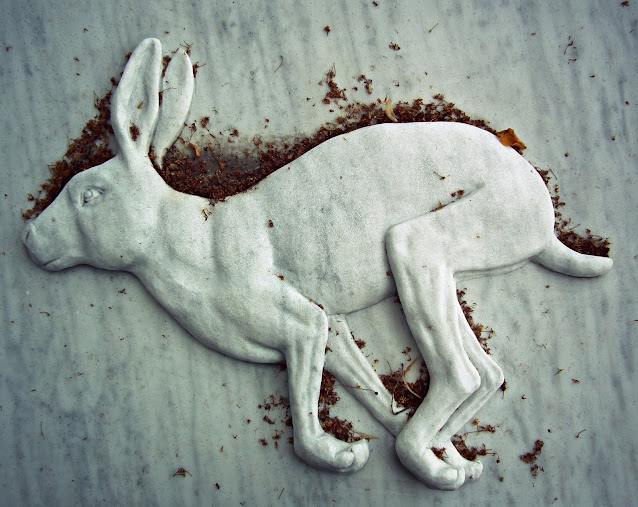
The
memorial of Dar Durnford Slater, who was born in 1897 and died in 1982 is
rather plain, tastefully lettered to be sure but very unshowy. It is a solidly middle-class
tombstone and on it Dar is described as mama, grandmoo and visabuela. It was a mixture of the unusual first name and
the Spanish word for grandmother that attracted my attention and made me wonder
if I could find out a little more about who was buried here and whether there
was an Iberian or South American connection.
Dar
Durnford Slater was born in Bayswater in July 1897 to George Samuel Ferdinando
and his wife Lilian Mabel (nee Duke). She was baptised with the doubly unglamourous
forenames Gladys Ethel on 18 July 1898 when the family were living at 29 Grove
End Road in St. John’s Wood in what would probably have been a substantial
family house (since demolished). Her father’s occupation is variously listed as
surveyor and estate agent but whatever he did, he was evidently very successful
at it as by 1911 the family were living at Shiprods Manor in the village of
Slinfold near Horsham in Sussex. George and Mabel had 5 children living with
them in the manor and 6 servants including a cook, a parlourmaid, two
housemaids, an under housemaid, a kitchen maid and a 19-year-old chauffeur. The family name is unusual being a corruption
of Ferdinand or possibly Fernandes. Her father appeared as a witness in a libel
case in January 1917 brought by a German national, a Mr Maximilian Lindlar, who
took the editor and publishers of the journal ‘The Pianomaker’ to court for accusing
him of using expressions unfriendly to England and of taking steps, after the
Services club had entered into possession of the German Athenaeum club, to oust
British officers from the premises. George Ferdinando appeared as a witness to
the defence and proudly told the judge that his family settled in England between
the sixteenth and seventeenth centuries. The earliest Ferdinando ancestors seem
to have been Portuguese Marranos who settled in England in the mid-17th
century. This distant relationship seems to have been Dar’s closest connection
to Iberia.

After
the end of the first world war Gladys Ethel married Alan Farquharson, a man 22
years her senior, probably in Jamaica. The marriage lasted only a short time as
Farquharson died in 1922 leaving her a widow at just 25. She married again in
1935, once again in the colonies but this time in India, in Bombay. This time her
husband John Durnford Slater, a British army officer, was 12 years younger than
her, a callow 26 to her 38. Her husband
became something of a celebrity in World War II when he became the first British
commando, appointed as the Lieutenant Colonel of No 3 Commando. Officering commando units was a more hands-on
role than senior army positions usually are and Durnford Slater took part in
several raids and did his fair share of strangling German guards with piano
wire on moonless nights in Norway. He was awarded the Distinguished Service Order
for his part in Operation Archery, a raid on the Lofoten Islands and the port
of Vaagso where the attack "lost five out of six officers, & nearly
40% of their effective [strength]" and was in danger of collapsing until he
personally stepped into the breach under heavy fire and took control. A
photograph of Durnford Slater collecting his DSO from Buckingham Palace
appeared in The Tatler in July 1942 and shows him with Dar and his
daughter Jennifer. He received a bar to his DSO (effectively meaning he was awarded
two DSO’s) for Operation Husky in Italy where he and his men held a bridge against
the Germans despite being outgunned and outnumbered. His citation said that he
showed a ‘complete disregard for [his own] personal safety’ during the
operation, something his men apparently found inspirational. There is a further
photograph of him collecting this award in 1944, again with Dar and a slightly
older Jennifer.
After
the war Durnford Slater went into the reserves and became a bursar at Bedford
School. He died in 1972 in mysterious circumstances at Haywards Heath station
according to The People of Sunday 06 February;
Brigadier
John Durnford Slater, Britain's first Commando in World War I, was killed
yesterday when he fell under the Brighton Belle train at Haywards Heath station,
Sussex. Brigadier Slater, 63, who lived in Brighton. was waiting on the
platform when the train went through at 60 m.p.h. Awarded the D.S.O. in 1942
for bravery in Norway. He wrote a book, "Commando" about his war
exploits.
If
there was an inquest (and there surely was) it seems not to have been reported
in the papers. If this had been a tragic accident then again you would expect
this to have been mentioned in the reports. It is very difficult not to conclude
that the war hero committed suicide. Probate records show that he left a very
small estate of just £1504. Dar would have been 75 at the time of her husband’s
death. If she was living in Brighton with him she must have moved back to
London otherwise, why would she be buried in Kensal Green?
The
headstone also memorialises Dar’s daughter Jennyfer, a biologist, whose ashes are
buried at Old Furzefield Wood (Potters Bar?).














